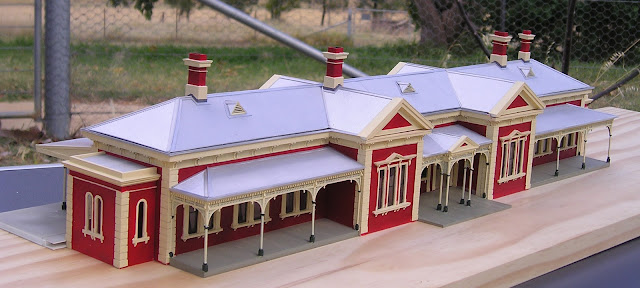Awning Painting for the Wagga station
The secret to successful painting, is subassemblies.
 |
| XPT in 2006 at the Wagga station Steel train on the mainline |
During the build of Wagga Station, I spent a lot of time considering how I would go about painting the model. Whilst the main red colour was sprayed, the masonry decorations were brush painted. This work had to happen before the awnings were added.
With a kit, one could trust the kit manufacturer to have all the dimensions correct, and things such as awnings and verandas could be treated as a subassembly, and prepainted prior to final fitting. But, my Wagga station, all the parts had to be cut and shaped to fit. So a lot of thought was put into designing a method where the parts could be disassembled after fitting for painting, and perhaps lighting down the track
 |
| The main station awning was connected to the station with 6 screws, accessed after removing the station roof |
 |
| The evergreen strips on the underside were painted Tamiya red-brown, after the awning underside had been sprayed silver (Tamiya aluminium) |
 |
| Once the awning had been removed, the etched brass support can be unclipped from the platform base. After cleaning, I placed this in a pickling bath of vinegar. The bath was previously made for the Murrumbidgee bridge lattices over 4 years ago. Good to find another use for it |
 |
| The front awnings were similarly disassembled. Here they are after the etches were spray painted, and the roof sprayed silver, and hand painted with the same Taubmans sample pot paint colour used for the spraying. |
After reassembly
 |
| The main platform ended up a lot lighter than I had originally hoped, but the lighter grey doesn't detract, and reflects light better into the shadows. It can be resprayed if people don't like it. And after the silver paint dried on the main platform awning, there were some visible variations in the paint coverage. A second coat may have fixed it. An alternative, which may be better was to try a subtle powdering weathering technique that simulates some age. It is a technique that may be applied to the main roof later |
Next stage.
Still have the downpipes, and other small detailing, but Bob, in a comment last blog, asked if I would be making the two other buildings on the platform. These are the Gents toilet block, and the former Parcels store.
So, here is a hint for a future blog post.
 |
| Roadside view - showing all 3 structures that make up the full station. The Gents toilet block is on the left, and the parcels storage building on the right. Both these are in the process of being made. |
Until next time






























